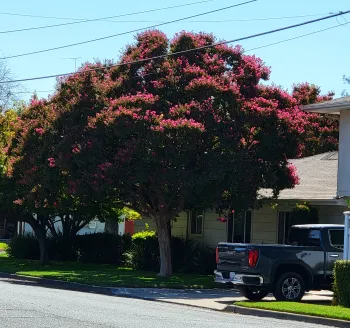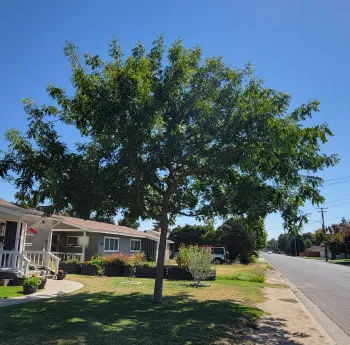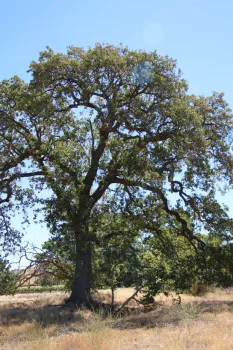
Many beautiful varieties of shade trees are well-suited to our Central Valley climate. Fall is the perfect time to plant a tree that will provide shade for your landscape for years to come!
Small Trees – to 30 feet tall
Chaste Tree (Vitex agnus-castus)
This gorgeous deciduous tree has a round or vase shape with colorful purple, pink, or white blossoms in the spring and summer. Chaste trees like full sun and need low water once it is established. Growing quickly to 15 feet height and a width of 15-20 feet, it will provide a small canopy of shade in the hot summer months. Early pruning in the winter will help it to keep its lovely shape.
Crape Myrtle (Lagerstromemia spp.)
One of the loveliest shade trees is the Crape Myrtle. Growing from 3 to 50 feet, this tree’s flowers come in a variety of shades including white, pink, lavender, red, and purple. It prefers full sun, and it is adaptable to many soil conditions. Drought-tolerant once established, they take minimal care (prune lightly in the fall) and can live for many years. I had a crape myrtle in my yard that was over 50 years old!
If you notice the tree is dropping sticky leaves and blossoms it may be infested with aphids. This often happens when trees are stressed. Make sure to give the tree deep water, wetting the area under the canopy to a depth of 18” during the dry season. If the sticky mess persists, consult an arborist.
Palo Verde (Parkinsonia spp.)

Palo Verde are native to southwestern USA and parts of Mexico. They are tough, deciduous, fast-growing, drought-tolerant trees that grow 15 to 30 feet tall with intricately arranged branches. The bark and branches are often green in color. In springtime, clusters of bright yellow flowers form. These trees are attractive to birds and bees. Palo Verde trees thrive in full sun and require little water once established, and do not tolerate overwatering. Prune to remove low or crossing branches. These trees are an excellent choice for those seeking low maintenance yet striking addition to their landscapes.
Oklahoma Redbud (Cercis canadensis var. texensis ‘Oklahoma’)
What makes this tree especially stunning are the flowers that bloom in winter on bare branches. Its striking purple-red flowers make it a wonderful addition to a landscape. This deciduous tree grows at a moderate pace. Reaching between 15 and 25 feet tall with a width of about 25 feet, it grows well in full sun, needing moderate water once established.
Western Redbud (Cercis occidentalis)
The Western Redbud, a California native, is a familiar sight in the foothills of the Central Valley. Like the Oklahoma redbud, it puts on a show in winter. Growing to a height of 10-20 feet with a width of 15 feet, its branches fill with showy magenta blossoms with beanlike pods forming after the flowers. It tolerates some shade and uses very low water once it is established.
Medium Trees – 30 – 50 Feet Tall
Australian Willow (Geijera parviflora)

This evergreen tree, with its rounded, willow-like shape and texture, has olive-colored leaves and showy, cream-colored flowers that bloom twice a year. It needs full sun and medium water and grows quickly to a height of 30-35 feet with a width of 20 feet. Prune in spring, not winter, carefully shaping the tree.
Chinese Pistache (Pistacia chinensis)
The Chinese Pistache is a hardy, drought-tolerant tree that provides abundant shade in the summer and stunning red, orange, and yellow foliage in the fall. It can tolerate most soil conditions but prefers a well-drained spot with plenty of sunshine.
Growing to a height of 20 to 35 feet, while spreading 20 to 30 feet wide, this tree will cast cool shade over much of your space.
Large Trees - over 50 feet tall.
Oak Trees, Coast Live Oak or Valley Oak (CA Natives) (Quercus agrifolia or lobata)
Not all oak trees are native to California. Two found in our area that thrive are the valley oak and coast live oak.Both grow over 80 feet tall and provide food for pollinators and other wildlife, in addition to a lot of shade. They grow slowly, so you may not get to enjoy the shade of this tree, but the next generation will!
Tulip Tree (Liriodendron tulipifera)
The tulip tree is a lovely large shade tree, growing in height from 60 to 80 feet tall. This moderately growing tree has wide-spreading branches that, in the late spring, bloom with 2-inch yellowish tulip shaped flowers that complement its tulip shaped leaves. Its leaves turn a similar yellow to its flowers in the fall. Tulip trees grow best in full sun. Young trees can have trouble with frost and are susceptible to several types of root rot (see sources for more information).
Choosing the right shade tree for your yard and landscape will not only give you a pleasant spot to sit and enjoy the summer but can provide you with beauty and joy for all seasons. Read more in depth about shade trees for our area, including planting and pruning tips in our free publication, Trees in Your Home Garden at https://ucanr.edu/sites/default/files/2020-12/341553.pdf
Sources:
Arborists - Trees are Good. https://www.treesaregood.org/findanarborist/findanarborist
Managing Pests in Gardens: Trees and Shrubs: Australian willow—UC IPM
Managing Pests in Gardens: Trees and Shrubs: Chaste Tree—UC IPM
Managing Pests in Gardens: Trees and Shrubs: Chinese Pistache—UC IPM
Managing Pests in Gardens: Trees and Shrubs: Crape Myrtle—UC IPM
Managing Pests in Gardens: Trees and Shrubs: Redbud—UC IPM
Managing Pests in Gardens: Trees and Shrubs: Tulip Tree (Yellow Poplar)—UC IPM
Managing Pests in Gardens: Trees and Shrubs: Palo Verde—UC IPM
Terry Pellegrini has been a UC Master Gardener of Stanislaus County since 2020.
